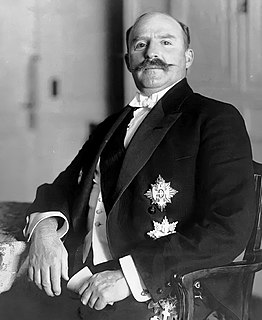
Essad Pasha Toptani or Esad Pasha Toptani, mainly known as Essad Pasha, was an Ottoman army officer who served as the Albanian deputy in the Ottoman Parliament. He was a prominent politician in early 20th-century Albania. Toptani cooperated with the Balkan League after the Balkan Wars and established a state in central Albania, based in Durrës, called the Republic of Central Albania.

Ali Pasha, variously referred to as of Tepelena or of Janina/Yannina/Ioannina, or the Lion of Yannina, was an Ottoman Albanian ruler who served as pasha of a large part of western Rumelia, the Ottoman Empire's European territories, which was referred to as the Pashalik of Yanina. His court was in Ioannina, and the territory he governed incorporated central and southern Albania, most of Epirus and the western parts of Thessaly and Greek Macedonia. Ali had three sons: Muhtar Pasha, who served in the 1809 war against the Russians, Veli Pasha, who became Pasha of the Morea Eyalet and Salih Pasha, governor of Vlorë.

The Congress of Lushnjë, historically documented by the name Mbledhja Kombiare Lushnje, was a conference of Albanian political leaders held from January 28 to January 31, 1920 in Lushnjë, Albania.

Mustafa Merlika-Kruja was one of the signatories of the Albanian Declaration of Independence. He served as Prime Minister of Albania during the Italian occupation from December 4, 1941 to January 19, 1943.

The Albanian Declaration of Independence was the declaration of independence of Albania from the Ottoman Empire. Independent Albania was proclaimed in Vlorë on 28 November 1912. Six days later the Assembly of Vlorë formed the first Government of Albania which was led by Ismail Qemali and the Council of Elders (Pleqnia).

Mufid bej Libohova was an Albanian economist, diplomat and politician and one of the delegates at the Assembly of Vlorë where the Albanian Declaration of Independence took place. He served as the first Minister of Interior of Albania, during the Provisional Government of Albania and since then has held different government positions on nine occasions between 1913–1927, holding the positions of Justice Minister, Minister of the Interior, Minister of Finances, and Minister of Culture.

Syrja Vlora (1860–1940), usually referred as Syrja Bey Vlora, was an Ottoman Albanian politician, an active figure of the Albanian Declaration of Independence in 1912 and one of the delegates of the Assembly of Vlorë.
Riza Kryeziu (1847-1917), known as Riza Bey Gjakova, was an Albanian nationalist figure and guerrilla fighter, an influential bey in the Gjakova region, then part of the Vilayet of Kosovo, Ottoman Empire, and one of the activists of Albanian national movements of early 20th century.
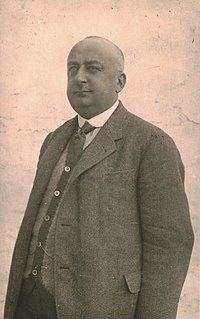
Sami Bey Vrioni (1876–1947) was an Albanian politician, diplomat, and a delegate at the Assembly of Vlora which declared the Albanian Declaration of Independence. He was a respected and powerful landowner in the Fier region of Albania.
The Albanian revolts of 1833–1839 took place in Albania as a reaction against the new centralizing policy of Ottoman administration.

The All-Albanian Congress or Albanian National Congress or Albanian Independence Congress was a held in Vlorë on November 28, 1912. Congress participants constituted the Assembly of Vlorë which established Albanian Provisional Government and elected Ismail Qemali as its president.

The Sanjak of Avlona was one of the sanjaks of the Ottoman Empire which county town was Berat in Albania. It was established in 1466, after the construction of the Elbasan Castle of the territory that belonged to the preceding Ottoman sanjak, Sanjak of Albania.
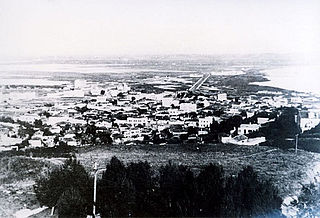
The Congress of Durrës was a conference of Albanian political leaders, held from December 25 to December 27, 1918, in Durrës, at the time capital of the Principality of Albania.
The Elderly Assembly was a senate of Albania which independence was declared on 28 November 1912 in Vlorë. The senate was established on the 4 December 1912 by the Assembly of Vlorë. It was composed of 18 members of the assembly and had advisory role to the government of Albania.
Abdullah Pashe Taushani of Elbasan was a member of the Ali Pasha Tepelena's Supreme Council of the Armed Forces. Other members of the Council included Myftar Pasha, Veli Pasha, Xheladin bej Ohri and a number of his trusted men like Hasan Dervishi, Halil Patrona, Omar Vrioni, Meço Bono, Ago Myhyrdari, Thanasis Vagias, Veli Gega and Tahir Abazi.
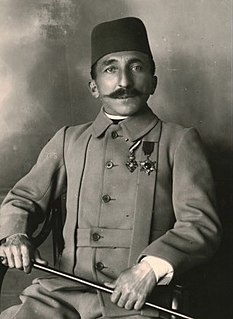
Hysni Curri (?–1925) was a Kosovar Albanian military figure and a prominent leader of the Kachak movement and the Committee for the National Defence of Kosovo.
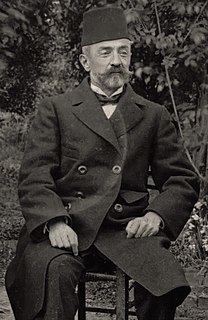
Aqif Pasha Biçaku mostly known as Aqif Pashë Elbasani was an Ottoman Albanian political figure in the Sanjak of Elbasan and after the Young Turk Revolution became an activist for the Albanian national cause.
Marenglen Verli (1951–) is an Albanian historian and scholar. Since 2009, he is a member of the Academy of Sciences of Albania.
The Second Congress of Manastir was an Albanian congress held on 2–3 April 1910 in Manastir, back then Ottoman Empire, today's Bitola in the Republic of Macedonia. It dealt with the challenges that the Albanian language and schools faced at the time within the context of the empire, and the platform to overcome them.
The Alltuni were a wealthy and powerful Albanian feudal family at a time when the present day territory of Albania was under Ottoman rule. For almost two centuries they ruled over the entire region of Kavajë and large parts of the Myzeqe plains.













